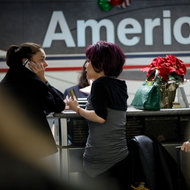As president and chief executive of Canada Goose, I’m flying continuously it seems, mostly to meet retailers and grow the brand. All the trips really are important to our company’s growth, so I won’t ever complain about business travel. I even like most airplane food. I always try to get a window seat. I’ve gotten some of my best ideas while staring at clouds or looking at landscapes from some 30,000 feet up. Plus, I get to control the window shade.
Our outerwear products have been used at the South Pole for decades, and I tried to get there a few years ago. Try is the operative word. I flew from Toronto into Santiago, Chile, and from Santiago to Punta Arenas, Chile.
We were supposed to fly from Punta Arenas to Antarctica and then on to the South Pole. But the pilot needed to know everything was clear since the flight is totally weather-dependent. Antarctica is huge, and was experiencing some bad weather. So we couldn’t take off, and one day stretched into two.
We got a hotel outside the city, but there were protests, general strikes and road blocks that started over fuel prices. Traffic was closed in and out of the city so we had to walk about 20 miles from the hotel to the airport only to find out we couldn’t take off because the bad weather continued. Finally, we got the go-ahead on Day 4 since the weather was clearing. But then, the pilot said the plane had a mechanical problem.
If I can take a weather delay, protests, a 20-mile walk and a canceled trip, a little flight delay at an airport that has restaurants isn’t going to bother me. The good news is I did finally make it to the South Pole the very next year.
I have a commercial pilot’s license. That makes me a very laid-back flier, but I have seen some strange things.
I happened to look out the window on a flight that was crossing the Atlantic, and I saw another plane, which looked pretty close to us. Seeing another plane isn’t really that big of a deal, but a few minutes later another plane came into the airspace. So there were three planes literally in formation flying across the ocean. The pilot came on the address system and told everyone not to be worried. I guess it was kind of like driving on the highway.
I don’t mind talking to seatmates. But on one flight to Amsterdam, I was seated in business class next to a guy who was, well, grumpy. It got worse when the attendant came around with beverages and somehow spilled coffee all over him.
He jumped out of the seat and started making this huge scene. I guess it’s understandable since the coffee was hot, but he was over the top. His clothes were ruined and the attendant said she’d get him something to wear. I think she got her revenge, because the only thing she could come up with was a pair of pajamas that looked like a jumpsuit or a huge onesie for an adult.
The airline logo was emblazoned on it and when the guy came out of the restroom wearing this get-up, he looked like a giant baby superhero. He grumbled the rest of the flight, but I’m not sure if he was still mad about the spill or about the way he looked.
I didn’t have any other beverages on the flight. If I had to change clothes, I would have looked equally silly in that thing.
By Dani Reiss, as told to Joan Raymond. E-mail: joan.raymond@nytimes.com.
Article source: http://www.nytimes.com/2013/05/14/business/walking-20-miles-for-a-canceled-flight-to-antarctica.html?partner=rss&emc=rss


